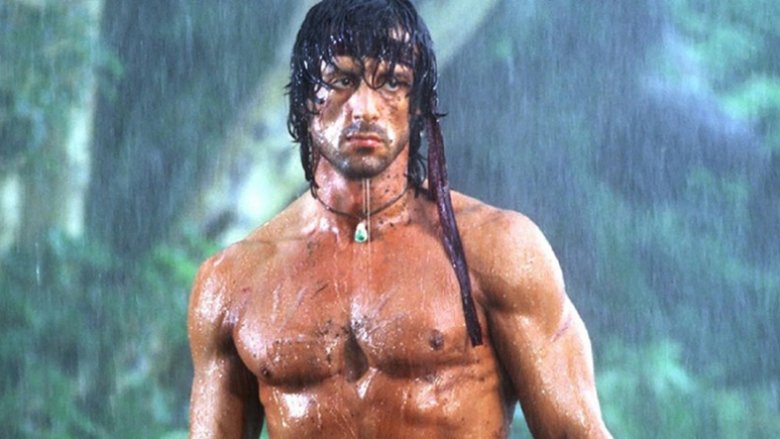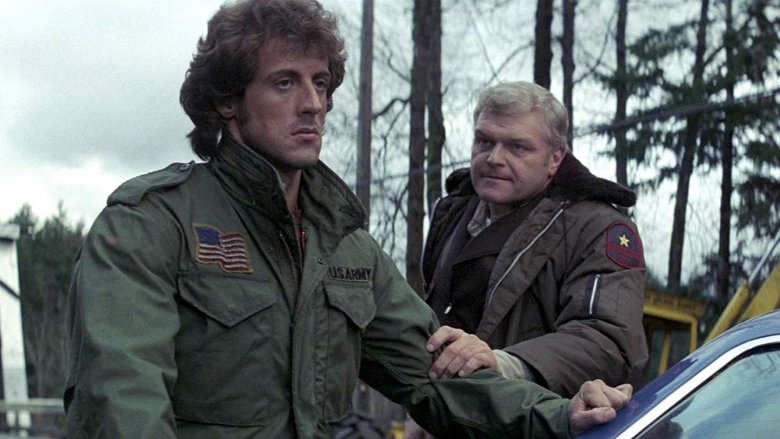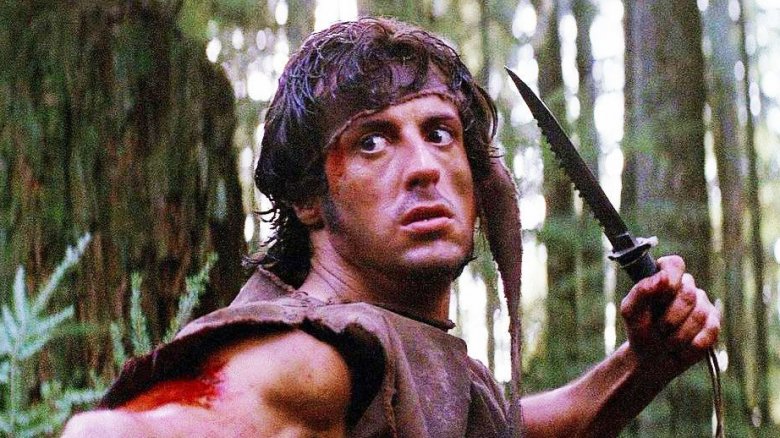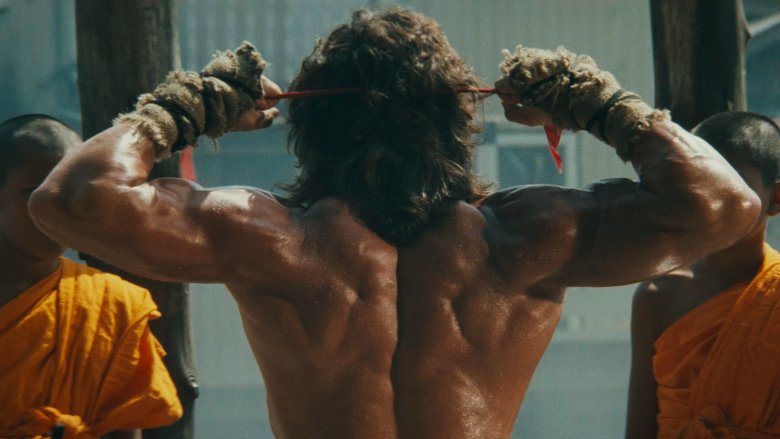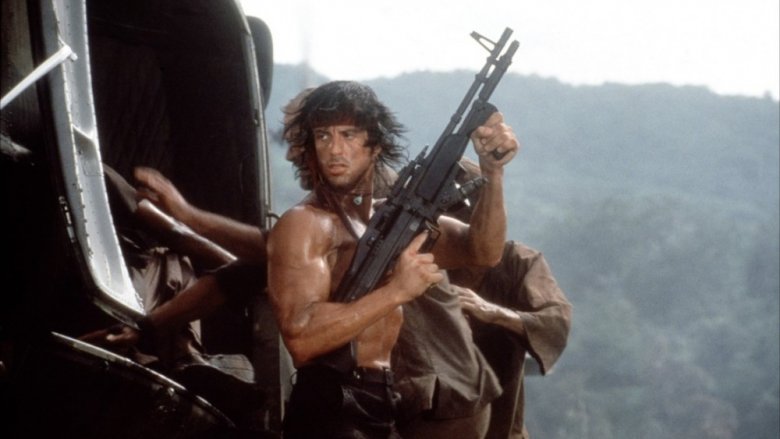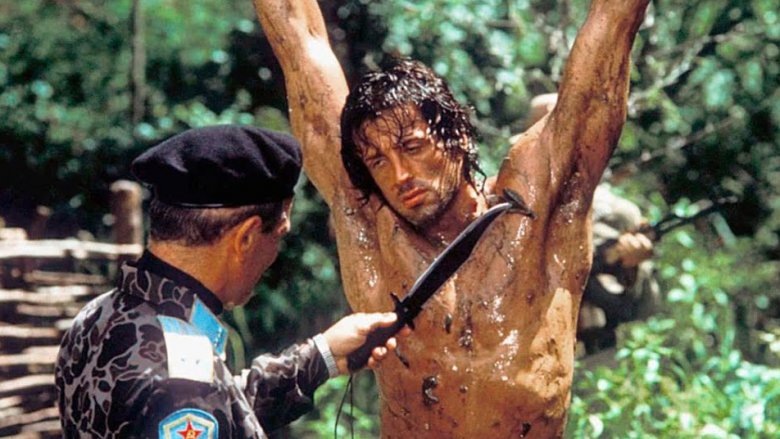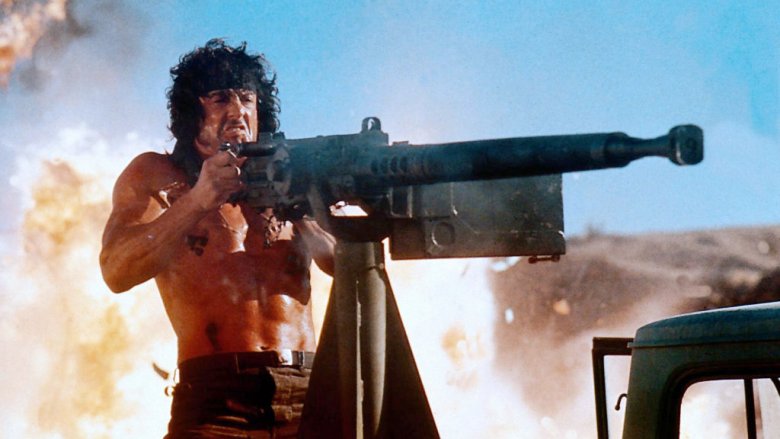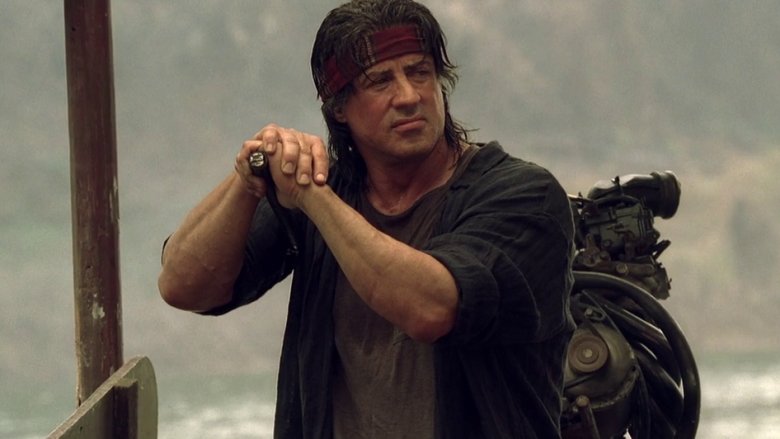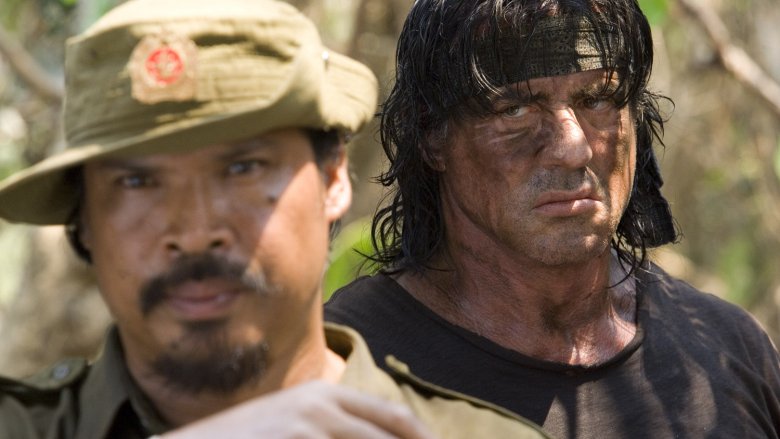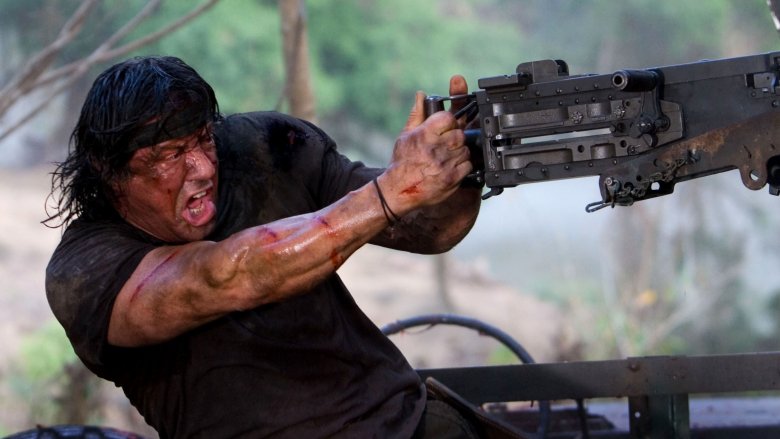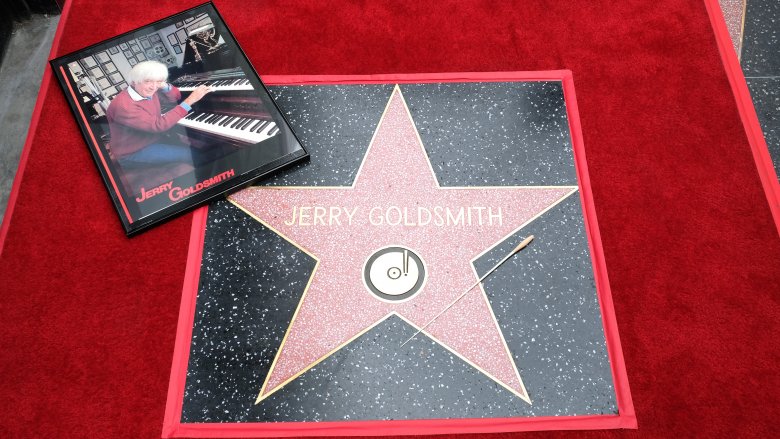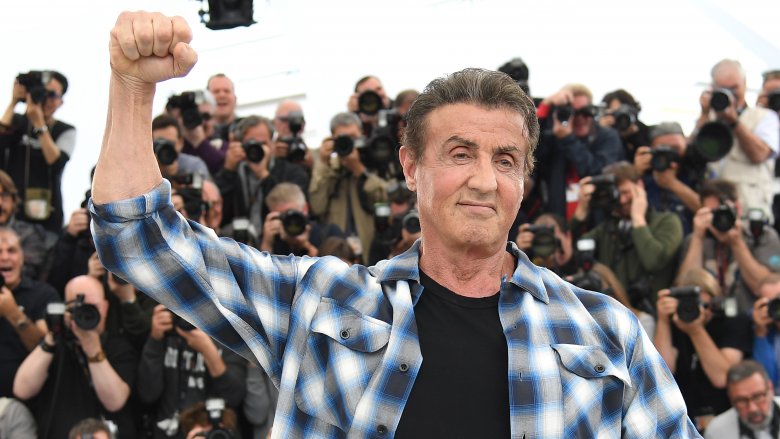These Things Happen In Every Single Rambo Movie
Sylvester Stallone is back for one more go-round as John Rambo, arguably the actor's second most iconic character after Rocky Balboa. It's been over a decade since the now-73-year-old star portrayed the one-man army, and the upcoming Rambo V: Last Blood sees the character in some unfamiliar territory. After four movies that featured Rambo constantly on the search for peace, Last Blood's trailer shows that he may have finally found it on his father's ranch ... at least for a while, anyway. Before long, trouble comes calling, and Rambo once again finds himself caught up in a vicious battle against some bad guys, as the grizzled vet heads to Mexico to take on a drug cartel.
Although Rambo V looks different in some aspects from its predecessors, there's a high probability that the film, once released, will bear more than a passing resemblance to the other four Rambo movies — 1982's First Blood, 1985's Rambo: First Blood Part II, 1988's Rambo III, and 2008's Rambo. That's because, despite a few differences between the films, there are several things that happen in every single Rambo movie. So try as Last Blood may to distinguish itself from Rambo's other outings, odds are pretty good the film will utilize most — if not all — of the items on the list below.
All Rambo movies deal with a real-world issue
We already know that Rambo V will be dealing with real-world issues in the form of Mexican drug cartels, but it's hardly the first time a Rambo movie will be doing so. As outlandish as they are, the plot of every Rambo movie so far has actually revolved around a real geopolitical issue of its time. In First Blood, John Rambo is a Vietnam veteran who's struggling with severe PTSD — a term that had come into widespread use following that war — which leads him into conflict with the local law enforcement of a small town.
In the second film, Rambo returns to Vietnam to search for missing American POWs, only to learn that the U.S. Government isn't actually interested in saving them. This was a hot-button political issue in the 1980s, as some believed the Southeast Asian nation was still holding prisoners from the war, and that the American government was covering it up.
Rambo III puts the commando in Afghanistan to face off with the Soviet Army, which held a military presence in the country throughout the '80s. To fight the Red Menace, Rambo teams up with a group of Afghan fighters known as the Mujahideen — a plot that didn't age terribly well since Osama Bin Laden also fought for the group in the '80s. Finally, 2008's Rambo is set during the Saffron Revolution in Burma (Myanmar) and sees Rambo defending the Karen rebels from the Burmese government — a fact which led to the film being banned in the nation.
Rambo always wields a giant knife
When thinking of Rambo, you may picture him holding a bow and arrow, and you wouldn't be wrong — he uses that weapon a lot. But he hasn't used one in all of his movies. One weapon that does get that distinction is his giant knife.
In every single one of his outings, Rambo utilizes some type of big knife, and his carving utensils have become so iconic that they've even spawned their own genre of blades. The knives used by Rambo in each of the first three films can best be categorized as survival knives. The smallest of the bunch appears in First Blood, and Stallone had it custom made for the film by knifesmith Jimmy Lile, with the idea being to create a survival knife that was unique from anything on the market. For the second film, Stallone again turned to Lile but doubled down, and ended up with a knife that was larger, more curved, and more extreme than the original.
For Rambo III, Stallone decided to go with a fantasy-inspired blade from a different knifemaker, Gil Hibben, of whom the actor was a fan. This knife was bigger still than its predecessors and, arguably, way flashier. For Rambo, the star went a more old school route, with Rambo crafting his own crude (and huge) machete-type knife in the film — though in reality, it's still a Hibben design. The big knife tradition will continue in Rambo V, with the character wielding a massive blade designed by Dietmar Pohl. And just so you know that Rambo isn't messing around, this knife is called the "Heartstopper."
He always dons a headband
For a survivalist and hardcore military man, Rambo sure is particular about his accessories. In addition to always carrying around his customary huge knife, Rambo has also worn a headband in every single one of his movies. The trend started kind of by accident in First Blood, as the character uses a piece of his brown shirt to cover a head wound. The headband would go on to receive much more ceremony in the second film. After Rambo's love interest is killed, Rambo tears off a piece of her red dress and ties it around his head in dramatic fashion. He then proceeds to go on a vengeance-filled killing spree, as one does.
From this point on, Rambo would always reach for a red headband specifically. He wears one in Rambo III, which again has a dramatic scene of him tying it on — by then the universal signal that stuff was about to go down. In Rambo, he goes for a slightly more stylish look, donning a red bandanna with different colored stripes. In the trailer for Rambo V, there's no headband in sight, and it looks like the headwear enthusiast has traded in his collection for a cowboy hat. Also, given his new short hairdo, maybe Rambo finds the headband cumbersome. But given the importance of the garment in every other Rambo movie, we'd be shocked if he didn't throw one on at some point in the new film.
Rambo always saves someone
There's a reason why Rambo, as violent as he is, is considered by many to be a hero. It's because he's always saving someone. Rambo doesn't get into fights because he wants to. He does it because he's pushed to his limit by villains who are inflicting harm on others. In First Blood II, Rambo is sent to Vietnam specifically on a rescue mission to save American POWs, which he does. Then in Rambo III, he goes to Afghanistan on another rescue mission. This time, it's to save his former commander (and closest friend), Col. Trautman, which he does. In Rambo, the character is living in Thailand when he's hired by some missionaries to ferry them to Burma. The missionaries are captured by Burmese militants, and it's up to Rambo to rescue them ... which he does.
So what about First Blood? Well, in the original film, Rambo doesn't stage a rescue of anyone, but he does save himself. John Rambo is the innocent in the film who's picked on by those in power — in this case, the corrupt law enforcement officers who wrongfully arrest him. To save himself from this injustice after being pushed beyond his limits, he inadvertently transforms into the ultimate warrior. He then proceeds to give those who mistreated him a major reckoning. Rambo V will continue this trend, with the film's story reportedly seeing Rambo travel to Mexico to rescue his friend's daughter who's been kidnapped.
All Rambo movies feature a torture scene
Given that Rambo is a Vietnam war veteran who suffers from PTSD, it's not surprising that every Rambo film to date has a scene that depicts torture in one form or another. In the original movie, the torture scene proves extremely pivotal to the plot. After being taken into custody by a bunch of backwoods cops, Rambo is roughed up and held against his will while an officer attempts to dry shave him. This triggers a flashback for Rambo, as he remembers being tied up and tortured with a knife in Vietnam. The flashback causes him to lash out and attack the officers, which kicks off the Rambo vs. cops showdown.
The other Rambo movies don't make their torture scenes quite as pivotal, but they're still present. In the second film, Rambo is tortured on two occasions. First, the Vietnamese hang him by his arms in a pool of leech-infested mud, leaving him there for an extended period of time. Then, a group of Soviets electrocute Rambo while interrogating him. In Rambo III, for once it isn't Rambo who gets tortured. Instead, that fate belongs to Col. Trautman, who's in Soviet custody for a chunk of the film. Rambo rescues him just as he's about to be tortured with a flamethrower. In Rambo, the man rescues a group of hostages who are forced to race each other through land mine infested-water as soldiers bet on who will emerge victorious. Since Rambo V reportedly deals with a kidnapping, another torture scene is all but assured.
Rambo goes on a machine gun rampage near the end of every film
If you've ever seen any Rambo movie, you've probably come to the conclusion that Rambo likes guns. Sure, he's into knives and bows and all sorts of weapons, but firing a big machine gun seems to really get the guy pumped. So it's no wonder that near the end of every Rambo movie so far, the ex-soldier goes on a vengeful tear with the biggest gun he can find.
In First Blood, Rambo steals an M60 machine gun and just destroys the police station where his nemesis, Sheriff Will Teasle, is hiding out. In his next outing, Rambo does nearly the exact thing thing. He takes a helicopter machine gun and lights up the office of Major Marshall Murdock, the military suit who wanted Rambo's rescue mission to fail. In Rambo III, during the climactic clash between the Soviets and the Mujahideen, Rambo takes control of a massive, truck-mounted machine gun to inflict some major damage on the Russians. He does something similar — but with far greater impact — at the end of Rambo. After hijacking a jeep-mounted, .50 caliber machine gun, Rambo shreds the Burmese army in the most gruesome scene in the entire franchise. And given Stallone's penchant for one-upping himself, we should probably expect an even more over-the-top machine gun freak out at the end of Rambo V.
He's always just scraping by
Despite the success of his movies — First Blood Part II was the second-highest grossing film domestically in 1985 — Rambo himself has been perpetually poor since his first appearance. In First Blood, he has neither a job nor a home. He's just a drifter with an unkempt appearance. And he's faring even worse in the sequel, as the film opens with Rambo in prison for his rampage in the first movie.
In Rambo III, the former Special Ops soldier is living in a Buddhist monastery in Thailand, where he's still not making enough to open a savings account. Instead, he's engaging in underground stick fighting tournaments for cash (which he gives away) and doing some construction work for the monks. In Rambo, the character is still living in Thailand (probably due to the low cost of living). He performs a few odd jobs to get by, including catching snakes, being a fisherman, and giving boat rides up the Salween River, which runs near the border of Thailand and Burma.
At the conclusion of the last film, Rambo finally returns home to his father's ranch in Arizona. This is where he's still living at the start of Rambo V, and in the trailer, it looks like he has at least one horse he tends to, so we guess he's making a living as a rancher now? Either way, he still doesn't appear to be raking in the dough, which is to be expected.
Rambo kills more people every movie
Rambo kills people, that much is obvious. But what you may not know is the older Rambo gets, the more people he kills. So far, every Rambo movie has featured more kills than its predecessor. In First Blood, Rambo doesn't purposely kill anyone. Only one police officer dies in the film, and it happens by accident after he falls out of a helicopter while pursuing Rambo. This was meant to be a key aspect of the character, as he'd already seen enough bloodshed in Vietnam. However, that all went out the window in Rambo II, as the character slaughters 58 people, according to the calculations of the L.A. Times' John Mueller. Mueller also calculated Rambo's kills in the other films as well, finding that the action hero murders 78 bad guys in Rambo III and a record 83 in Rambo.
Given the character's bloody history (and Stallone's tendency to top his previous outings), we fully expect Last Blood to feature more Rambo kills than ever. The trailer alone shows at least four people killed directly, with what looks like scores more likely perishing in explosions. Honestly, we wouldn't be shocked at all if Rambo tops himself and kills 100 villains in Rambo V.
He always hijacks a vehicle
If there's one thing John Rambo is good at — besides killing people, tying headbands, and creating a market for absurdly large knives — it's hijacking vehicles. He doesn't really care what type of vehicle it is: motorcycle, truck, helicopter, tank, etc. As long as it can get him from Point A to Point B, Rambo is likely to swipe it. This tradition kicked off, like all others we've discussed, in First Blood. After escaping from the police station, Rambo knocks a passer-by off his motorcycle and steals it, using it to flee into the forest. Near the end of the film, he "borrows" a military supply truck from the National Guard and uses it to launch his final assault on the town.
In the sequel, he hijacks a helicopter from the Vietnamese and uses it to blow up their base. Rambo III features Rambo's most ridiculous hijacking, as he takes over a tank at the end of the film and crashes it head-first into a helicopter being flown by the Soviet commander Col. Zaysen. And in Rambo, he hijacks an enemy truck and uses its gun turret to make mulch out of the Burmese militants. With Rambo heading south of the border for Rambo V, he's going to need a vehicle to get there, right? Something that allows him to go incognito, most likely. And the drug cartels will certainly have many such vehicles. Do we smell another hijacking on the horizon?
Every single Rambo movie has music by Jerry Goldsmith
As we've hopefully established by now, there are a lot of things that make the Rambo franchise iconic, but one of the most underrated aspects of these movies is their music. Rambo films feature rousing scores that really get the blood pumping, and the main person we can thank for that is the late composer Jerry Goldsmith. Goldsmith, who scored dozens of films over his long career (including Mulan, The Omen, and Gremlins), wrote the entire score for the first three Rambo movies. Perhaps his most notable contribution to the series is his song "It's a Long Road," which has become the character's de facto theme song and appears in all three Rambo films composed by Goldsmith.
Goldsmith passed away in 2004, meaning he wasn't around to score 2008's Rambo. But that didn't stop his music from showing up in the film. The movie's soundtrack was scored by composer Brian Tyler, who mostly made all-new music for the film in the style of Goldsmith. However, he also weaved in portions of Goldsmith's work throughout, and the end of the film fittingly features "It's a Long Road" as Stallone walks down the lengthy path to his father's ranch. The score functioned as a perfect tribute to Goldsmith, and with Brian Tyler returning for Rambo V, we have no reason to think that Goldsmith's music — especially "It's a Long Road" — won't find their way into Last Blood.
Sylvester Stallone co-wrote all the Rambo movies
As one of the most recognizable movie stars of the 1980s, Sylvester Stallone is best known as an actor. But he's also an accomplished director and an even more accomplished screenwriter. Stallone wrote the script for 1976's Rocky, which earned him an Oscar nomination for Best Original Screenplay. He went on to write the next five Rocky movies, and wouldn't you know it, he's also had a hand in writing every single Rambo movie.
First Blood was an adaptation of the novel of the same name by author David Morrell. The film's screenplay was initially written by the team of Michael Kozoll and William Sackheim, but once Stallone came on board the project, the A-lister heavily rewrote the script. For First Blood Part II, Terminator scribe James Cameron was hired to write the script, but Stallone again heavily rewrote it prior to filming. He also co-wrote Rambo III with frequent Jean-Claude Van Damme collaborator Sheldon Lettich after reading Lettich's script Firebase and learning that the writer was an actual Vietnam veteran. Stallone then co-wrote Rambo with Art Monterastelli, and it remains the only Rambo film that Sly also directed. For Last Blood, it's more of the same, with Stallone sharing screenwriting duties with Matt Cirulnick, completing his pentalogy of Rambo screenplays.
